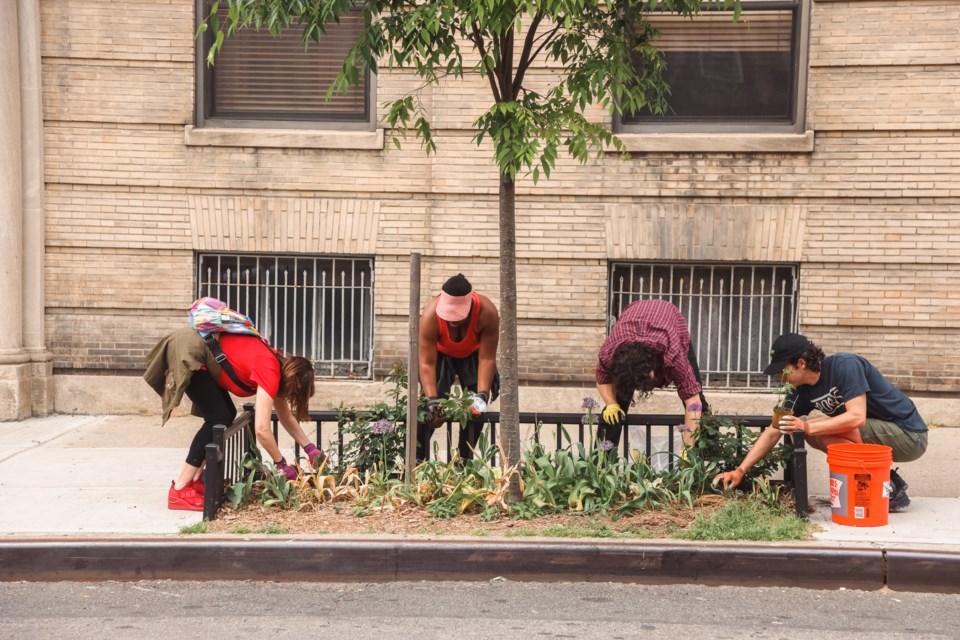By Brooklyn Council Member Alexa Avilés and NYC Environmental Justice Alliance's Shravanthi Kanekal and Victoria Sanders
In NYC, extreme heat is the leading cause of weather-related deaths with an average of 370 residents dying prematurely of extreme heat-related health impacts every year. Unfortunately certain demographic groups experience these impacts worse than others. Black NYC residents experience higher than average risks and more than twice the number of deaths compared to those in other racial categories. Outdoor workers in the US are up to 35 times more likely to die from heat exposure than the general population.
NYC is expected to experience double to triple 90+ degree days by 2050 (about 30 days per year) and longer, more frequent heat waves. In May, the World Meteorological Organization announced that global temperatures will likely rise to record levels over the next five years. The first week of July brought with it the record-breaking hottest average global temperature recorded. With these severe conditions on the rise, the number of heat-related health impacts will worsen, causing more fatalities, particularly among communities of color. That is, unless we do something now to address extreme heat.
There are many ways we can minimize and adapt to the ongoing and increasing threat of extreme heat in NYC. One of the most universally beneficial solutions is growing and maintaining our urban forest, which includes NYC’s 7+ million trees, from street trees to those in parks and other private and public property. These trees provide various benefits to the city and its residents including shade, filtering air pollution, reducing flooding and pollutants in waterways, and mitigating extreme heat effects by cooling the ambient temperature.
Studies have documented that historically underinvested communities, such as neighborhoods that were redlined, experience hotter temperatures than neighborhoods that weren’t. Many of these same neighborhoods are home to today’s environmental justice communities which are close in proximity to noxious infrastructure and often have less access to open, natural spaces.
As illustrated by the NYC Heat Vulnerability Index which identifies the most heat-vulnerable parts of NYC, residents in these neighborhoods are more vulnerable to extreme heat due to lower vegetation in these areas, in addition to other socio-economic factors. Neighborhoods like the Upper West Side, nestled closely to Central Park, are significantly cooler during summer months than those in the South Bronx and Sunset Park, where trees are few and far between. As documented by The Nature Conservancy, Council District 38 had only about 14% canopy cover as of 2017 (the most recent year for which data are available) - substantially lower than the 22% citywide canopy level, and ranking in the bottom third of all Council Districts. Further, tree canopy in Council District 38 is not evenly distributed – about 40% it is concentrated in a combination of Green-Wood Cemetery and Sunset Park, meaning that there is less canopy to provide local benefits in other parts of the district, particularly from the Gowanus Expressway west to the waterfront.
Over the last several years, the NYC Environmental Justice Alliance (or NYC-EJA, a citywide network of community-based organizations of color fighting for greater equity) has brought attention to minimizing the disproportionately negative effects of extreme heat on environmental justice communities. In 2020, we successfully advocated for legislation requiring the City to accurately account for heat-related mortality and produce an annual city-wide heat emergency plan. Our focus is on improving air quality and reducing emissions to address the compounding health impacts from heat coupled with bad air quality. NYC-EJA works to maximize “cooling” strategies, including advocating for the equitable expansion of the urban forest, increased access to cooling centers, and increased home energy assistance.
The City’s recently released strategic climate plan, PlaNYC, outlines important ideas but doesn’t go far enough to create actionable plans to mitigate the climate risks it highlights. It mentions achieving 30% tree canopy coverage but fails to set a timeline, concrete strategy, or funding stream to ensure that this goal is met in a timely and sustainable manner. Time is of the essence, with extreme heat silently killing hundreds each year.
While NYC has programs in place to protect residents from the dangers of extreme heat, such as cooling centers, warning systems, and more, many of these fall grossly short of providing equitable and consistent protection that meets the needs of residents across the five boroughs. If we continue to deprioritize timely action, the impacts of climate change will worsen, and impacts to human life will increase.
We must collectively work to reduce the disparities in environmental justice communities and increase the management and amount of vegetation in NYC. We need 30% tree canopy cover across the city by 2035 with equitable distribution and fully functioning management systems outlined in a city-wide urban forest plan to ensure that we plan for long-term results. We need to better track and monitor our tree canopy and vegetation so that we have an ongoing and up-to-date accounting of the urban forest so that stewardship can be fostered and simplified.
These goals require continued and increased funding for parks and trees in our city to ensure that in the decades to come, the urban forest can be properly cared for to continue growing and protecting the city and its residents.
Alexa Avilés is a City Council Member representing the 38th district.
Shravanthi Kanekal is a Resiliency Planner and Victoria Sanders is a Research Analyst at the NYC Environmental Justice Alliance.




